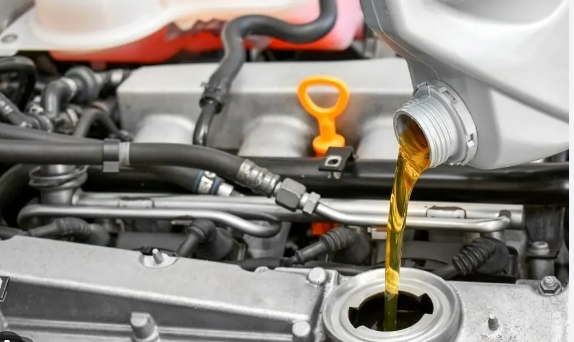Adding oil can help a car start if the lack of oil was preventing it from starting. Inadequate oil levels can lead to engine damage, so it is important to check the oil level regularly and add oil as needed.
Maintaining proper oil levels in your car is crucial for its smooth functioning and longevity. When your car fails to start, it can be due to various reasons, one of which could be a low oil level. Oil lubricates the engine components and prevents friction that can cause severe damage.
This article will explore whether adding oil can make your car start and why it is essential to monitor oil levels to prevent potential engine problems. By understanding the significance of proper oil levels, you can ensure your car’s optimal performance and avoid costly repairs. So, let’s dive in and find out how oil affects the starting mechanism of your car.
The Role Of Oil In Car Engines
The Role of Oil in Car Engines
Oil plays a critical role in the functioning of car engines. One of its primary functions is to lubricate moving parts such as pistons, crankshafts, and camshafts. This lubrication reduces friction and prevents metal-on-metal contact, which can cause excessive wear and damage. Without oil, these components would quickly deteriorate, leading to engine failure and costly repairs.
In addition to lubrication, oil also helps maintain the proper engine temperature. As the oil circulates through the engine, it absorbs heat from the combustion process and transfers it to the oil cooler or radiator. This cooling effect prevents overheating and ensures that the engine operates within its optimal temperature range.
Regular oil changes are essential to keep the engine running smoothly. Fresh oil provides better lubrication and heat transfer capabilities, prolonging the engine’s overall lifespan. Ignoring regular oil changes can lead to decreased performance, increased fuel consumption, and potential engine damage. Therefore, it is crucial to adhere to the recommended oil change intervals specified by the vehicle manufacturer.
Signs Of Low Oil Level
Adding oil to your car can have a direct impact on its ability to start. One of the signs of low oil level is the appearance of warning lights on your car’s dashboard. These lights serve as an indication that the oil level is below the recommended threshold. Ignoring these warning lights could lead to serious engine problems.
Another sign of low oil level is the presence of an engine knocking noise. When oil levels are low, the engine is not properly lubricated, causing components to rub against each other. This friction results in a knocking sound that is indicative of potential engine damage.
Additionally, excessive exhaust smoke can also be a sign of low oil level. leading to oil burning can cause internal engine parts to overheat, leading to oil burning and the generation of dark smoke from the exhaust system.
It is important to address low oil levels promptly to avoid further damage to your car’s engine. Regularly checking and maintaining the oil level can help prolong the lifespan of your vehicle and ensure it starts without any issues.
Reasons Why Adding Oil May Help Start The Car
Adding oil to your car can actually help with starting the engine. This is due to several reasons:
- Improved lubrication for efficient engine function: When you add oil to your car, it helps lubricate the engine’s moving parts, reducing friction and allowing them to work smoothly. This can help the engine start more easily, especially in cold weather conditions.
- Reduction in engine friction: Oil acts as a lubricant, creating a protective barrier between the moving metal parts of the engine. This reduces friction, which can make it easier for the engine to turn over and start.
- Prevention of engine overheating: Proper lubrication from oil helps dissipate heat generated during engine operation. Without enough oil, the engine may overheat, leading to starting issues. By maintaining the proper oil level, you can help prevent engine overheating and promote smoother starts.
How To Add Oil To Your Car
Adding oil to your car is an important maintenance task that helps ensure the smooth functioning of the engine. To perform this task, you will need a few supplies, including a funnel, a rag or paper towel, and the appropriate type and amount of oil for your vehicle.
To begin, you’ll need to locate the oil dipstick and oil cap. The oil dipstick is typically marked with a bright color and can be found near the engine. The oil cap is usually located on top of the engine and is also labeled.
Before adding oil, make sure to park your car on a flat surface and turn off the engine. Use the rag or paper towel to clean the area around the oil dipstick and cap. Next, remove the oil cap and insert the funnel into the oil fill hole. Carefully pour the oil into the funnel, taking care not to spill.
After adding the oil, use the dipstick to check the oil level. Insert the dipstick back into the dipstick tube, then remove it to see the oil level. If needed, add more oil until it reaches the recommended level.
Common Mistakes To Avoid When Adding Oil
Adding oil to a car is a common maintenance task, but it’s important to do it correctly to avoid potential problems. One common mistake to avoid is overfilling the engine with oil. This can lead to excessive pressure and can cause seal damage, leading to leaks. It’s essential to follow the manufacturer’s guidelines and not exceed the recommended oil level.
Another mistake is using the wrong type of oil. Each car has specific oil requirements, and using the wrong one can lead to poor lubrication and engine damage. Always refer to the vehicle’s owner manual or consult a professional to determine the correct oil viscosity and specification.
Neglecting to check the oil level after adding is another mistake to avoid. The dipstick should be used to verify that the oil level is within the appropriate range. If the level is low, more oil should be added, but care should be taken not to overfill.
Other Factors Impacting Car Starting
Adding oil to a car does not directly impact its ability to start. However, there are other factors that can affect a car’s starting performance.
Battery Issues:
A low or dead battery can prevent a car from starting. This can be caused by a variety of factors such as a faulty alternator, loose or corroded battery connections, or leaving on lights or accessories that drain the battery. Regular battery maintenance, including cleaning terminals and checking for signs of wear, can help prevent starting issues.
Fuel System Problems:
Issues with the fuel system, such as a clogged fuel filter or a malfunctioning fuel pump, can also impact a car’s starting. If the engine is not receiving the proper amount of fuel, it may struggle to start or not start at all. keeping the fuel system cleang changing the fuel filter and keeping the fuel system clean, can help prevent these problems.
Ignition System Malfunctions:
The ignition system, which includes components like the spark plugs and ignition coils, is responsible for igniting the fuel in the engine. If any part of the ignition system is faulty or worn out, it can cause starting problems. Regular inspection and replacement of worn out components can help ensure the ignition system is functioning properly.
When Adding Oil Will Not Solve The Starting Problem
Adding oil to a car may not always solve starting problems. In some cases, severe engine damage could be the root cause. This could result from issues like a blown head gasket, a cracked engine block, or a worn-out piston. These problems typically require extensive repairs and may even necessitate an engine replacement.
In addition to engine damage, starting issues can also be caused by mechanical failure in other components. For instance, a faulty fuel pump or a clogged fuel filter can prevent the proper flow of fuel to the engine, resulting in difficulties starting the car. Similarly, a malfunctioning starter motor or a weak battery might not provide the necessary power to start the engine.
Furthermore, problems with the ignition or electrical system can also hinder the car from starting. A faulty ignition switch, ignition coil, or spark plugs can disrupt the ignition process, leading to starting problems. Similarly, a malfunctioning starter solenoid or a damaged wiring connection can cause issues in the electrical system, preventing the car from starting.
In conclusion, while adding oil can sometimes help with starting problems, it is important to consider other potential issues as well. Severe engine damage, mechanical failure in other components, and ignition or electrical system problems can all contribute to difficulties starting a car.
Maintenance Tips To Ensure Smooth Car Starting
Regular oil changes are essential for maintaining a smooth car starting experience. Oil acts as a lubricant for the engine components, reducing friction and preventing wear and tear. It also helps in keeping the engine cool by absorbing heat. Oil changes help in removing dirt and debris from the engine, ensuring efficient functioning.
Checking and maintaining proper oil levels is crucial for the longevity of the engine. Low oil levels can lead to engine overheating and mechanical failures. It is important to address any warning signs, such as the oil light illuminating on the dashboard, immediately.
Ignoring these signs can result in serious engine damage. By prioritizing regular oil changes and addressing any issues promptly, you can ensure that your car starts smoothly and performs optimally.
Conclusion
Adding oil to a car can potentially make it start if the issue is related to low oil levels or lack of lubrication. However, it is important to monitoring of oil levels can help preventeed fix for a non-starting car.
It is crucial to diagnose and address the underlying issue, such as a faulty starter or a drained battery. Consulting a professional mechanic is recommended for a proper diagnosis and repair. Remember, regular maintenance and monitoring of oil levels can help prevent such issues in the first place.


Leave a Reply